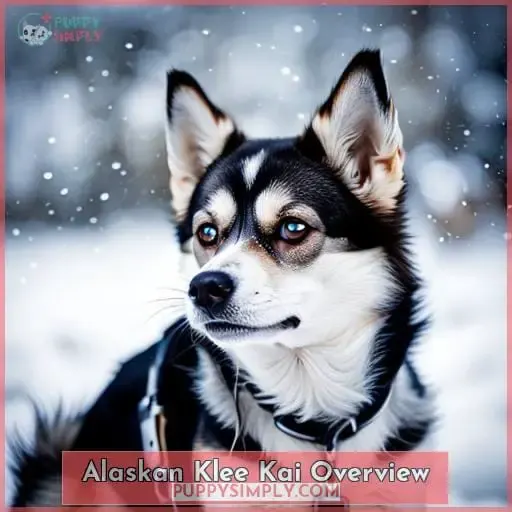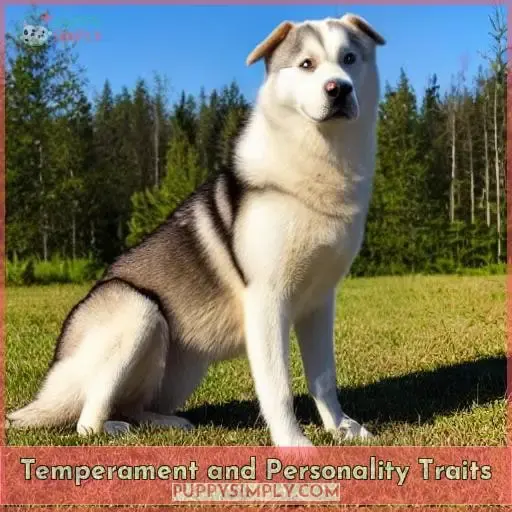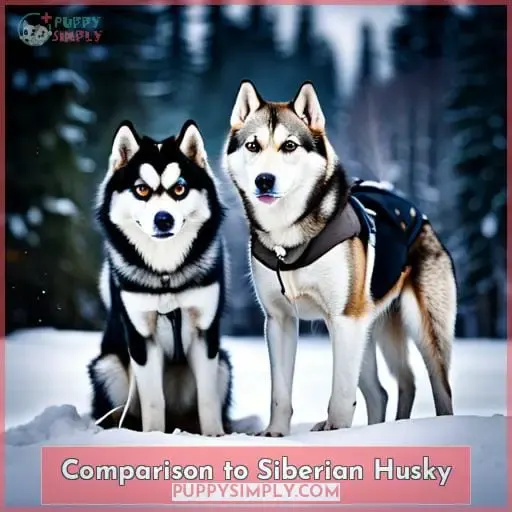This site is supported by our readers. We may earn a commission, at no cost to you, if you purchase through links.
 Have you yearned for an affectionate yet manageable pup?
Have you yearned for an affectionate yet manageable pup?
If Siberian Huskies seem too large yet their looks appeal, explore Alaskan Klee Kais.
Though rare, these spunky, amusing pups boast Husky markings in smaller, cuddlier packages.
As experienced judges and trainers, we find well-bred Klee Kais adapt beautifully indoors yet relish brisk walks or runs.
Research ethical breeders thoroughly and consider welcoming one of these delightful companions into your heart and home.
Table Of Contents
- Key Takeaways
- Alaskan Klee Kai Overview
- Size Variations
- Temperament and Personality Traits
- Exercise and Training Needs
- Grooming Requirements
- Health and Lifespan
- Origin and History
- Comparison to Siberian Husky
- Finding an Alaskan Klee Kai Breeder
- Bringing Home an Alaskan Klee Kai Puppy
- Frequently Asked Questions (FAQs)
- Conclusion
Key Takeaways
- Rare husky descendant with a devoted, smaller size yet energetic temperament
- Appearance resembles huskies; lively intelligence makes them mischievous
- High daily exercise and training needs for physical and mental stimulation
- Weekly brushing and grooming required due to heavy seasonal shedding
Alaskan Klee Kai Overview
You’ll find the Alaskan Klee Kai, a rare Husky descendant, sharing many traits with its sled dog cousins, but bred to be a devoted, smaller companion.
As miniature companions, these pint-sized pups charm with their Husky-esque appearance, lovingly scaled down.
Their lively, mischievous intelligence makes them ideal watchdogs, quick to alert families to anything unusual.
They require about an hour of daily exercise and play to meet their high activity needs.
Historically developed in the 1970s, breeder Linda Spurlin discovered an undersized Alaskan Husky and worked to recreate the breed in a smaller package.
They come in three size variations – Toy, Miniature, and Standard – that primarily differ in height and weight but share the same delightful temperament.
With moderate grooming needs, they promise to shower owners with affection.
Size Variations
Alaskan Klee Kais come in three size variations: toy, miniature, and standard.
The toy stands up to 13 inches tall.
The miniature hits 13 to 15 inches.
The standard ranges from 15 to 17 inches tall.
Despite the different names, there is minimal size difference between the three types.
Toy
Coming off the overview, you’ll find the Alaskan Klee Kai comes in three size variations: toy, miniature, and standard.
The smallest is the toy at up to 13 inches tall and 5-8 pounds.
As the dog show judge, I always look for proportionate toy Alaskan Klee Kais with moderate exercise needs.
Work closely with reputable breeders for healthy toy-sized pups and use positive reinforcement when training these intelligent yet sensitive dogs.
Miniature
You’re looking at Miniature Alaskan Klee Kais if their height ranges from 13 to 15 inches tall.
Miniature Marvels have the exact same loyal, playful spirit of their larger cousins in an itty-bitty package.
These Diminutive Delights are tiny treasures with bigger-than-life personalities.
They make wonderful petite pals for folks seeking spunk in a smaller dog.
Though small in stature, size matters not to these active, devoted companions when it comes to coat color, grooming needs, and training.
Standard
Having covered the miniature size variation, you’re now learning about the standard Alaskan Klee Kai.
The standard Alaskan Klee Kai stands 15 to 17 inches tall and typically weighs between 12 and 20 pounds.
When selecting a standard pup:
- Prioritize health tests from reputable breeders.
- Consider energy level and training needs.
- Prepare for a 10-15 year commitment.
With proper care and training, standards make wonderful companions that deeply bond with their families.
Their versatile size suits many homes while retaining the breed’s compact husky-like appearance.
Temperament and Personality Traits
When living with an Alaskan Klee Kai, you’ll find them to be intelligent and affectionate companions.
Energetic and eager to please, these small dogs are known for their easy trainability and quick mastery of commands.
Though playful and mischievous at times, exhibiting their active natures by playing tricks on owners, Alaskan Klee Kai are also watchful guardians of their families.
Socialization training from puppyhood onward will ensure friendliness with strangers, while their exercise needs are satisfied through enthusiastic daily play and walks.
With proper care and training, their spirited temperaments and affectionate loyalty shine through, making Alaskan Klee Kai rewarding companions.
Exercise and Training Needs
With their high energy levels and working breed roots, Alaskan Klee Kais require daily exercise and mental stimulation to stay happy and well-behaved.
Interactive training through playful exercises like fetch, tug-of-war, and obstacle courses provide physical activity and reinforce the human-dog bond.
Mental stimulation from dog puzzles, hide-and-seek games, and scentwork training also taps into their natural intelligence.
Positive reinforcement and consistency are key when training an Alaskan Klee Kai, as they’re highly trainable but can be independent thinkers.
Proper socialization techniques starting in puppyhood ensure they become well-adjusted companions.
Providing adequate outlets for an Alaskan Klee Kai’s energy and mind prevents problematic behaviors like excessive barking, digging, chewing, and other destructive habits.
Overall, they need vigorous daily activity paired with training games to thrive in family life.
Grooming Requirements
Although you’ll need to brush their coats weekly, an Alaskan Klee Kai’s grooming needs are relatively minimal for a double-coated spitz breed.
As a companion to this bright-eyed toy breed, commit to weekly brushings with a slicker brush to remove dead hairs and keep their thick double coats tidy.
Be prepared for heavy seasonal shedding in the spring and fall by having deshedding tools on hand.
Trim nails every few weeks and clean ears regularly to avoid infections.
While bathing isn’t needed often, use a mild dog shampoo when their coats get dirty.
For any eye stains, gently wipe the area daily with a sterile pad and canine eye wash.
Overall, a modest time investment in brushing and coat care will keep your Klee Kai looking healthy and dapper.
Health and Lifespan
You’re looking at a life expectancy of 13-16 years for your Alaskan Klee Kai.
Common health issues to watch for include:
- Luxating patella
- Autoimmune thyroiditis
- Heart murmurs
- Factor VII deficiency
As a veterinarian with experience treating Alaskan Klee Kais, here are 4 key health considerations I advise my clients keep in mind:
- Schedule annual vet checkups to monitor for potential issues.
- Create a balanced diet and exercise plan to maintain healthy weight.
- Brush frequently to minimize shedding and skin irritation.
- Socialize properly and watch interactions with children due to small size.
Staying informed on common Alaskan Klee Kai health concerns will help you provide the best care for your rare Husky descendant.
With proper prevention and treatment when necessary, your clever companion should thrive by your side for over a decade.
Monitoring weight, coat, behavior, and annual exams are vital for their wellbeing.
Origin and History
After researching the origin and history of the Alaskan Klee Kai breed, you’d learn that it was developed in the 1970s.
Breeder Linda Spurlin bred a small Siberian Husky with other Huskies to create a miniature version.
As an arctic breed expert and enthusiast, I admire Spurlin’s dedication in developing this rare canine lineage.
Through selective breeding rooted in loyalty and companionship, she embarked on a journey to build an intimate arctic companion in a smaller, family-friendly package.
Her efforts resulted in a miniature Husky with the watchdog qualities intact, ultimately achieving AKC recognition in 1997.
Though still uncommon, Alaskan Klee Kais make devoted and gentle companions for children and other pets when socialized properly.
Their rarity today mirrors the breed’s relatively recent roots, but their popularity continues rising as people discover these affectionate little watchdogs.
Comparison to Siberian Husky
You’ll notice some key similarities and differences when comparing the Alaskan Klee Kai to its ancestral cousin, the Siberian Husky.
While the Klee Kai shares the Siberian’s thick double coat, pricked ears, and strong prey drive, it diverges in its much smaller size and tendency to bond closely with its family.
Size: The Klee Kai stands just 13-17 inches tall compared to the Husky’s much larger 21-24 inch frame.
Energy: The Klee Kai has lower exercise requirements at 30-60 minutes per day versus the Husky’s more demanding 60+ minutes.
Affection: Klee Kais form intensely close bonds with their people, while Huskies tend to be more independent.
Roaming: The Husky needs solid containment as their instinct is to wander, unlike the homebody Klee Kai.
Care must be taken to research breeders and rescue groups dedicated specifically to the rare Klee Kai, as their needs differ from those of typical Siberian Huskies despite some common ancestry.
Finding an Alaskan Klee Kai Breeder
When looking for an Alaskan Klee Kai breeder, you’d do well to research their reputation and confirm health testing of the parent dogs prior to bringing one of their pups home.
Reputable breeders will proudly share health testing results for conditions like patellar luxation and autoimmune thyroiditis.
During your screening process, ask to meet the puppies’ parents and inspect the premises for cleanliness and proper socialization.
The best breeders focus on health and temperament over appearance. They’ll interview you thoroughly as well, wanting their pups placed in loving forever homes.
Establishing a relationship with an ethical, responsible breeder ensures you find a healthy, well-adjusted Klee Kai who’ll bring years of companionship.
Bringing Home an Alaskan Klee Kai Puppy
Once you’ve prepared your home for your new puppy’s arrival, focus on making their first days relaxing.
Let them bond through play and cuddle time.
Socialize your puppy gently with new sights, sounds, people, and other pets at their own pace to build confidence.
Begin short, positive reinforcement training sessions on basic commands like sit, stay, and come.
Follow your breeder or vet’s guidelines for nutrition, feeding schedules, and appropriate toys/chews.
Make playtime bonding activities like fetching, tug-of-war, and hide-and-seek a daily routine.
Introduce regular grooming like brushing, nail trims, and teeth cleaning so they become used to handling.
Stay patient – your Alaskan Klee Kai puppy is still getting to know their new family and environment.
Keep things low-key as you establish routines together.
Frequently Asked Questions (FAQs)
What kinds of foods and treats do Alaskan Klee Kais enjoy?
As their sled dog cousins, Alaskan Klee Kais thrive on high-quality protein sources like fish, meat, eggs, and dairy.
Use their eager-to-please nature during training by rewarding good behavior with bite-sized real meat treats.
Their active lifestyle calls for nutrient-dense commercial dog foods formulated specifically for high energy breeds.
Monitor treats to avoid overfeeding.
How much living space does an Alaskan Klee Kai need?
Although they’re small dogs, Alaskan Klee Kais need adequate indoor space for play and exercise.
A small apartment may not provide enough room for their high energy levels.
Ensure your Klee Kai has access to both mental and physical stimulation.
Daily walks and interactive toys are a must.
Are Alaskan Klee Kais good with children?
Yes, Alaskan Klee Kais can be great with kids if properly socialized from puppyhood.
Their energetic, playful nature makes them ideal companions for children.
However, supervise all interactions due to the breed’s small size.
With early exposure and training, these loyal pups bond tightly with kids in their pack.
How often do Alaskan Klee Kais go into heat each year?
Alaskan Klee Kais typically experience two heat cycles per year.
The heat lasts 2-3 weeks.
Watch for signs like increased urination, swelling vulva, and behavioral changes.
To prevent accidental litters, closely supervise intact females and talk to your vet about safe temporary containment options during this time.
Are Alaskan Klee Kais easy to potty train?
Yes, Alaskan Klee Kais are typically easy to housetrain.
Their eagerness to please makes them receptive to positive reinforcement techniques.
Set a consistent schedule, use treats and praise for successes.
Patience and compassion create an environment for this clever companion to thrive.
Conclusion
Though petite, Alaskan Klee Kais contrast with Huskies, embodying comparable beauty and personality within an apartment-sized eminence.
Before acquiring an Alaskan Klee Kai, meticulously vet ethical breeders. Rigorously train and exercise them daily to channel their athleticism.
If prepared for an energetic yet endearing companion, these rare descendants of sled dogs could fill your home with joy for years.
















